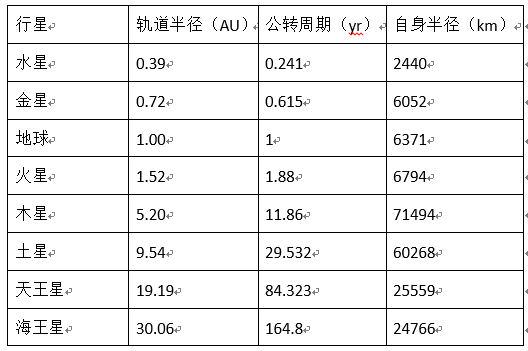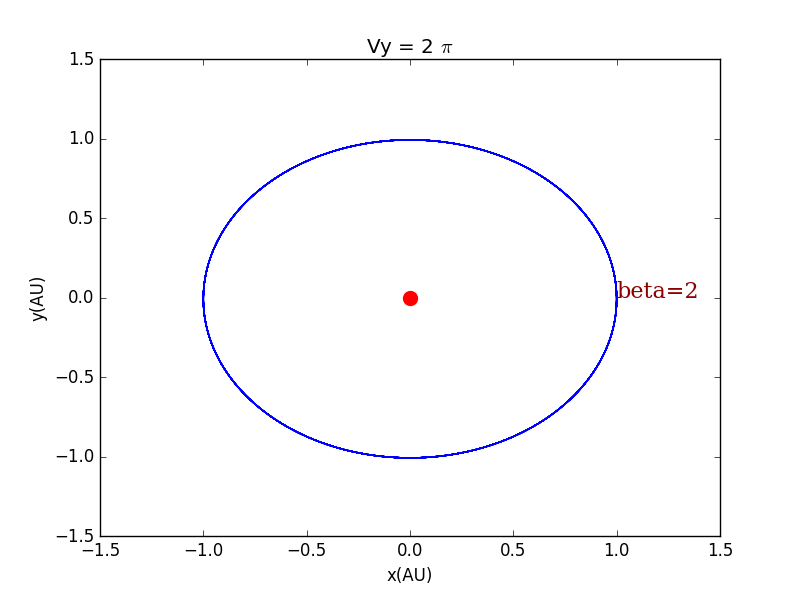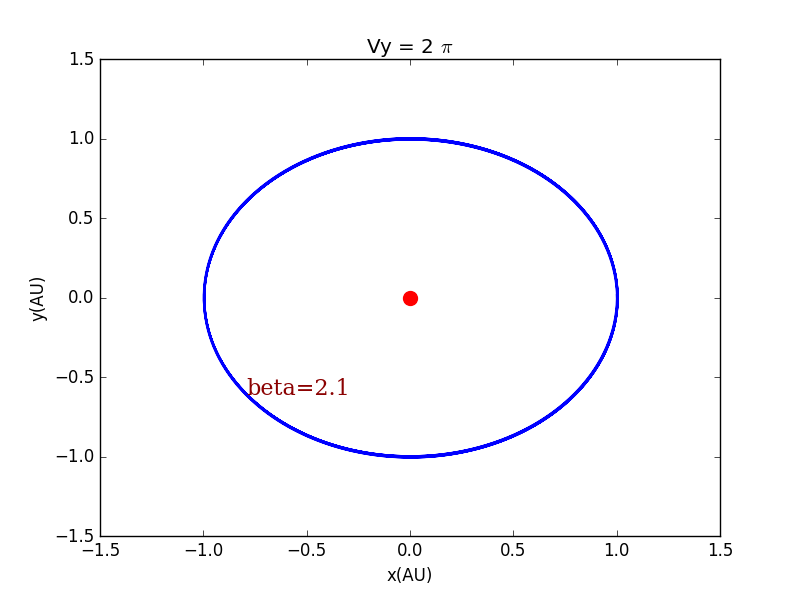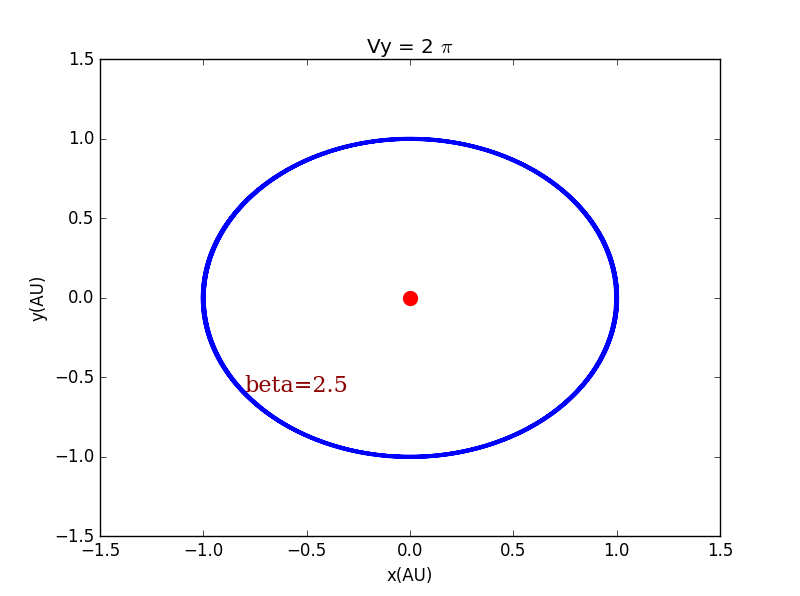@XF
2016-11-27T15:59:14.000000Z
字数 9323
阅读 88
在此处输入标题
作业
一、摘要

二、背景
Earth orbits the Sun,the equation is
From Newton's second law of motion we have
Using astronomical units,1AU is the average distance between the Sun and Earth.1 year is approximately ,We find
We new write each of the second-order differential equations as two first-order differential equations:
If the force go as,the gravitational force is of the form
The planets whose orbits deviate the most from circular are Mercury.The force law predicted by general relativity is
三、正文
1
import matplotlib.pyplot as pltimport numpy as npimport mathbeta=[2.01,2.10,2.50,3.00]x0=0y0=0class elliptical:def __init__(self,e=0.2,GMs=4*math.pi**2,dt=0.0001,time=4):self.e=eself.GMs=GMsself.x1=[1]self.y1=[0]self.vx1=[0]self.vy1=[2*math.pi*math.sqrt(1-self.e)]self.x2=[1]self.y2=[0]self.vx2=[0]self.vy2=[2*math.pi*math.sqrt(1-self.e)]self.x3=[1]self.y3=[0]self.vx3=[0]self.vy3=[2*math.pi*math.sqrt(1-self.e)]self.x4=[1]self.y4=[0]self.vx4=[0]self.vy4=[2*math.pi*math.sqrt(1-self.e)]self.dt=dtself.time=timeself.r1=[math.sqrt(self.x1[0]**2+self.y1[0]**2)]self.r2=[math.sqrt(self.x2[0]**2+self.y2[0]**2)]self.r3=[math.sqrt(self.x3[0]**2+self.y3[0]**2)]self.r4=[math.sqrt(self.x4[0]**2+self.y4[0]**2)]def calculate(self):for i in range(int(self.time//self.dt)):self.vx1.append(self.vx1[i]-self.GMs*self.x1[i]*self.dt/self.r1[i]**(beta[0]+1))self.vy1.append(self.vy1[i]-self.GMs*self.y1[i]*self.dt/self.r1[i]**(beta[0]+1))self.x1.append(self.x1[i]+self.vx1[i+1]*self.dt)self.y1.append(self.y1[i]+self.vy1[i+1]*self.dt)self.r1.append(math.sqrt(self.x1[i+1]**2+self.y1[i+1]**2))for j in range(int(self.time//self.dt)):self.vx2.append(self.vx2[j]-self.GMs*self.x2[j]*self.dt/self.r2[j]**(beta[1]+1))self.vy2.append(self.vy2[j]-self.GMs*self.y2[j]*self.dt/self.r2[j]**(beta[1]+1))self.x2.append(self.x2[j]+self.vx2[j+1]*self.dt)self.y2.append(self.y2[j]+self.vy2[j+1]*self.dt)self.r2.append(math.sqrt(self.x2[j+1]**2+self.y2[j+1]**2))for i in range(int(self.time//self.dt)):self.vx3.append(self.vx3[i]-self.GMs*self.x3[i]*self.dt/self.r3[i]**(beta[2]+1))self.vy3.append(self.vy3[i]-self.GMs*self.y3[i]*self.dt/self.r3[i]**(beta[2]+1))self.x3.append(self.x3[i]+self.vx3[i+1]*self.dt)self.y3.append(self.y3[i]+self.vy3[i+1]*self.dt)self.r3.append(math.sqrt(self.x3[i+1]**2+self.y3[i+1]**2))for j in range(int(self.time//self.dt)):self.vx4.append(self.vx4[j]-self.GMs*self.x4[j]*self.dt/self.r4[j]**(beta[3]+1))self.vy4.append(self.vy4[j]-self.GMs*self.y4[j]*self.dt/self.r4[j]**(beta[3]+1))self.x4.append(self.x4[j]+self.vx4[j+1]*self.dt)self.y4.append(self.y4[j]+self.vy4[j+1]*self.dt)self.r4.append(math.sqrt(self.x4[j+1]**2+self.y4[j+1]**2))def show_results(self):ax1=plt.subplot(221)ax2=plt.subplot(222)ax3=plt.subplot(223)ax4=plt.subplot(224)plt.sca(ax1)plt.plot(self.x1,self.y1,label='trajectory')plt.scatter(x0,y0)plt.title(r'$\beta=2.01$'+ 'Simulation of elliptical orbit',fontsize=10)plt.xlabel(u'x(AU)',fontsize=10)plt.ylabel(u'y(AU)',fontsize=10)plt.sca(ax2)plt.plot(self.x2,self.y2,label='trajectory')plt.scatter(x0,y0)plt.title(r'$\beta=2.10$'+ 'Simulation of elliptical orbit',fontsize=10)plt.xlabel(u'x(AU)',fontsize=10)plt.ylabel(u'y(AU)',fontsize=10)plt.sca(ax3)plt.plot(self.x3,self.y3,label='trajectory')plt.scatter(x0,y0)plt.title(r'$\beta=2.50$'+ 'Simulation of elliptical orbit',fontsize=10)plt.xlabel(u'x(AU)',fontsize=10)plt.ylabel(u'y(AU)',fontsize=10)plt.sca(ax4)plt.plot(self.x4,self.y4,label='trajectory')plt.scatter(x0,y0)plt.title(r'$\beta=3.00$'+ 'Simulation of elliptical orbit',fontsize=10)plt.xlabel(u'x(AU)',fontsize=10)plt.ylabel(u'y(AU)',fontsize=10)plt.xlim(-1,1)plt.ylim(-1,1)plt.legend(fontsize=10,loc='best')a=elliptical()a.calculate()a.show_results()plt.show()
2
import matplotlib.pyplot as pltimport numpy as npimport mathalfa=0.0008x0=0y0=0xp=[]yp=[]tp=[]theta=[]class elliptical:def __init__(self,GMs=4*math.pi**2,dt=0.0001,time=2):self.GMs=GMsself.x=[0.47]self.y=[0]self.vx=[0]self.vy=[8.2]self.dt=dtself.time=timeself.r=[math.sqrt(self.x[0]**2+self.y[0]**2)]self.t=[0]def calculate(self):for i in range(int(self.time//self.dt)):self.vx.append(self.vx[i]-self.GMs*self.x[i]*self.dt/self.r[i]**3-alfa*self.GMs*self.x[i]*self.dt/self.r[i]**5)self.vy.append(self.vy[i]-self.GMs*self.y[i]*self.dt/self.r[i]**3-alfa*self.GMs*self.y[i]*self.dt/self.r[i]**5)self.x.append(self.x[i]+self.vx[i+1]*self.dt)self.y.append(self.y[i]+self.vy[i+1]*self.dt)self.t.append(self.t[i]+self.dt)self.r.append(math.sqrt(self.x[i+1]**2+self.y[i+1]**2))def precession(self):for j in range(len(self.r)-2):if (self.r[j+1]**2-self.r[j]**2>0 and self.r[j+1]**2-self.r[j+2]**2>0):xp.append(self.x[j+1])yp.append(self.y[j+1])tp.append(self.t[j+1])if self.x[j+1]>=0 and self.y[j+1]/self.x[j+1]>=0:theta.append(math.atan(self.y[j+1]/self.x[j+1])*180/math.pi)if self.x[j+1]>=0 and self.y[j+1]/self.x[j+1]<0:theta.append(math.atan(self.y[j+1]/self.x[j+1])*180/math.pi+360)if self.x[j+1]<0 and self.y[j+1]/self.x[j+1]>=0:theta.append(math.atan(self.y[j+1]/self.x[j+1])*180/math.pi+180)if self.x[j+1]<0 and self.y[j+1]/self.x[j+1]<0:theta.append(math.atan(self.y[j+1]/self.x[j+1])*180/math.pi+180)def show_results(self):for j in range(len(xp)):plt.plot([0,xp[j]],[0,yp[j]])plt.plot(self.x,self.y,'g',label=r'$\alpha$=0.0008'+' trajectory')plt.scatter(x0,y0)#plt.scatter(tp,theta,label='trajectory')plt.title(r'$\alpha$=0.0008'+' Simulation of the precession of Mercury ',fontsize=14)plt.xlabel(u'x(AU)',fontsize=14)plt.ylabel(u'y(AU)',fontsize=14)#plt.xlabel(u'time(yr)')#plt.ylabel(u'$\Theta$(degrees)',fontsize=14)#plt.xlim(-1,1)#plt.ylim(-1,1)plt.legend(fontsize=14,loc='best')a=elliptical()a.calculate()a.precession()a.show_results()plt.show()
3
import matplotlib.pyplot as pltimport numpy as npimport mathalfa=[0.0003,0.0005,0.0008,0.0015,0.0035]xp=[[],[],[],[],[]]yp=[[],[],[],[],[]]tp=[[],[],[],[],[]]theta=[[],[],[],[],[]]xy=[[],[],[],[],[]]x2=[[],[],[],[],[]]x_mean=[]y_mean=[]xy_mean=[]x2_mean=[]xy1=[]x21=[]xf=np.linspace(0,2,200)yf=[]class elliptical:def __init__(self,GMs=4*math.pi**2,dt=0.0001,time=2):self.GMs=GMsself.x=[[0.47],[0.47],[0.47],[0.47],[0.47]]self.y=[[0],[0],[0],[0],[0]]self.vx=[[0],[0],[0],[0],[0]]self.vy=[[8.2],[8.2],[8.2],[8.2],[8.2]]self.dt=dtself.time=timeself.r=[[math.sqrt(self.x[0][0]**2+self.y[0][0]**2)],[math.sqrt(self.x[0][0]**2+self.y[0][0]**2)],[math.sqrt(self.x[0][0]**2+self.y[0][0]**2)],[math.sqrt(self.x[0][0]**2+self.y[0][0]**2)],[math.sqrt(self.x[0][0]**2+self.y[0][0]**2)]]self.t=[[0],[0],[0],[0],[0]]self.a=[]self.b=[]def calculate(self):for n in range(len(alfa)):for i in range(int(self.time//self.dt)):self.vx[n].append(self.vx[n][i]-self.GMs*self.x[n][i]*self.dt/self.r[n][i]**3-alfa[n]*self.GMs*self.x[n][i]*self.dt/self.r[n][i]**5)self.vy[n].append(self.vy[n][i]-self.GMs*self.y[n][i]*self.dt/self.r[n][i]**3-alfa[n]*self.GMs*self.y[n][i]*self.dt/self.r[n][i]**5)self.x[n].append(self.x[n][i]+self.vx[n][i+1]*self.dt)self.y[n].append(self.y[n][i]+self.vy[n][i+1]*self.dt)self.t[n].append(self.t[n][i]+self.dt)self.r[n].append(math.sqrt(self.x[n][i+1]**2+self.y[n][i+1]**2))for j in range(len(self.r[n])-2):if (self.r[n][j+1]**2-self.r[n][j]**2>0 and self.r[n][j+1]**2-self.r[n][j+2]**2>0):xp[n].append(self.x[n][j+1])yp[n].append(self.y[n][j+1])tp[n].append(self.t[n][j+1])if self.x[n][j+1]>=0 and self.y[n][j+1]/self.x[n][j+1]>=0:theta[n].append(math.atan(self.y[n][j+1]/self.x[n][j+1])*180/math.pi)if self.x[n][j+1]>=0 and self.y[n][j+1]/self.x[n][j+1]<0:theta[n].append(math.atan(self.y[n][j+1]/self.x[n][j+1])*180/math.pi+360)if self.x[n][j+1]<0 and self.y[n][j+1]/self.x[n][j+1]>=0:theta[n].append(math.atan(self.y[n][j+1]/self.x[n][j+1])*180/math.pi+180)if self.x[n][j+1]<0 and self.y[n][j+1]/self.x[n][j+1]<0:theta[n].append(math.atan(self.y[n][j+1]/self.x[n][j+1])*180/math.pi+180)for k in range(len(theta[n])):xy[n].append(tp[n][k]*theta[n][k])x2[n].append(tp[n][k]**2)x_mean.append(float(sum(tp[n]))/len(tp[n]))y_mean.append(float(sum(theta[n]))/len(theta[n]))xy_mean.append(float(sum(xy[n]))/len(xy[n]))x2_mean.append(float(sum(x2[n]))/len(x2[n]))self.a.append(float((xy_mean[n]-x_mean[n]*y_mean[n]))/float((x2_mean[n]-x_mean[n]**2)))self.b.append(float((x2_mean[n]*y_mean[n]-x_mean[n]*xy_mean[n]))/float((x2_mean[n]-x_mean[n]**2)))def fit(self):for k in range(len(alfa)):xy1.append(alfa[k]*self.a[k])x21.append(alfa[k]**2)x_mean1=float(sum(alfa))/len(alfa)y_mean1=float(sum(self.a))/len(self.a)xy_mean1=float(sum(xy1))/len(xy1)x2_mean1=float(sum(x21))/len(x21)a=float((xy_mean1-x_mean1*y_mean1))/float((x2_mean1-x_mean1**2))b=float((x2_mean1*y_mean1-x_mean1*xy_mean1))/float((x2_mean1-x_mean1**2))print a,bfor m in range(len(xf)):yf.append(a*xf[m]+b)def show_results(self):plt.plot(xf,yf,'g',label='least-squares line')plt.scatter(alfa,self.a,label='scatter')plt.title(u'Simulation of the precession of Mercury',fontsize=14)plt.xlabel(u'alpha',fontsize=14)plt.ylabel(u'$d\Theta/dt$(degrees/yr)',fontsize=14)plt.xlim(0,0.005)plt.ylim(0,60)plt.legend(fontsize=14,loc='best')a=elliptical()a.calculate()a.fit()a.show_results()plt.show()
四、结论
当,改变时



当,改变时时,行星轨道基本无变化。
三、致谢
感谢杜威同学对我本次作业的帮助!
